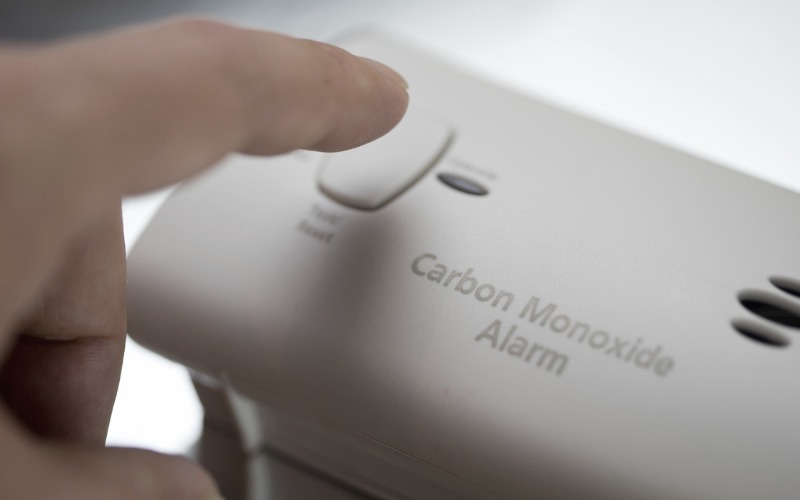Carbon monoxide is especially dangerous because it is incredibly hard to detect. It is odorless and cannot be noticed visually, which means that unless you are vigilant or have carbon monoxide detectors, you may not even know there is a problem. That being said, there are a few clues that can signal that you have got a serious leak occurring.
What is Carbon Monoxide Poisoning?
Carbon monoxide (CO) is a tasteless, colorless, odorless gas found in the fumes of fuels that contain carbon, such as wood, coal and gasoline. Carbon monoxide poisoning is a potentially fatal illness that occurs when people breathe in carbon monoxide.
Once inhaled, carbon monoxide passes from your lungs into your bloodstream, where it attaches to the hemoglobin molecules that normally carry oxygen. Oxygen cannot travel on a hemoglobin molecule that already has carbon monoxide attached to it. As exposure continues, the gas hijacks more and more hemoglobin molecules, and the blood gradually loses its ability to carry enough oxygen to meet your body’s needs. Without enough oxygen, individual cells suffocate and die, especially in vital organs such as the brain and heart. Carbon monoxide also can act directly as a poison, interfering with cells’ internal chemical reactions.
Effects of Chronic Exposure to Carbon Monoxide
Chronic exposure to carbon monoxide can have extremely serious long-term effects, depending on the extent of poisoning. The section of the brain known as the hippocampus is responsible for the formation of new memories and is particularly susceptible to damage.
Up to 40% of people who have suffered from carbon monoxide poisoning experience problems such as amnesia, headaches, memory loss, personality and behavioral changes, loss of bladder and muscle control, and impaired vision and coordination. These effects do not always present themselves immediately and can occur several weeks or more after exposure. Whilst the majority of people suffering from long-term effects of carbon monoxide poisoning recover with time, some people suffer permanent effects, particularly when it comes to organ and brain damage.
Symptoms of Carbon Monoxide Poisoning
Carbon monoxide poisoning can be particularly dangerous for people who are sleeping or intoxicated. People may have irreversible brain damage or even die before anyone realizes there’s a problem.
Early symptoms of exposure to CO, after breathing it for a short time, include:
- Dull headache
- Shortness of breath during mild exertion
- Weakness or fatigue
- Dizziness
Continued exposure to CO may result in:
- Nausea or vomiting
- Visual disturbances, such as blurred vision
- Difficulty concentrating
Prolonged exposure and lack of medical treatment may lead to serious and long-term effects and may even be life-threatening.
Carbon Monoxide in the Home
A malfunctioning or inappropriately used heating, cooking, or ventilation system in the home can allow leakage of carbon monoxide gas into the air, leaving you breathing toxic gas without knowing it.
Carbon monoxide can come from a number of sources within the home:
- Furnace systems and chimneys with leaks
- Kerosene heaters
- Wood-burning stoves and fireplaces
- Gas ranges
- Generators
- Appliances fueled by gasoline
- Gas-fueled space heaters
- Fireplaces that are not vented
- Cigarette and pipe smoke
What To Do If You Suspect a Carbon Monoxide Leak
If CO is detected with an alarm device, or if you suspect from your symptoms that you or your family members have been exposed to CO, leave the area of exposure immediately and go to the emergency department. Call the Poison Control Center at 1-800-222-1222 for further instruction. The gas company, oil company or local health authority can provide help in identifying and removing sources of CO contamination.
Preventing Carbon Monoxide Poisoning
Fuel-burning products and engines produce carbon monoxide, as do some chemical products, such as paint strippers. When engines are working properly and CO-producing products are used with appropriate ventilation, they aren’t normally a cause for concern. But when an engine’s exhaust is blocked in some way, or if CO-producing products are used in a closed space, the carbon monoxide can build to dangerous levels.
Follow these recommendations to help prevent carbon monoxide poisoning:
- Install a battery-operated or battery back-up CO alarm in the home and replace the batteries every year.
- Place generators as far from homes as possible (minimum of 25 feet), but also at a safe distance from any nearby dwellings.
- Never leave a car running in the garage or another enclosed space. CO can accumulate even when the garage door is open.
- Never use a generator, grill, camp stove, or other gasoline or charcoal-burning device inside a home, basement, garage, or outside near an open window.
- Never heat homes with a gas oven or by burning charcoal.
- Ensure that fuel-burning space heaters are properly vented.
- Maintain your heating system, water heater, and any gas, oil, or coal burning appliances with annual service appointments with a qualified technician.
- Do not use portable flameless chemical heaters indoors. These types of heaters burn gas and can cause CO to build up inside your home.
- Leave the building and dial 911 if a CO alarm sounds, if CO poisoning is suspected, or if any person begins to feel dizzy, light-headed or nauseous.
- After a major snowstorm, your car’s exhaust pipe may be blocked by snow, causing the gas to back up into the car. To protect yourself and your passengers from carbon monoxide poisoning, avoid being in the car with the engine running when there is a risk of your tail pipe being blocked.
Final Thoughts
Chances are, you have got a perfectly safe gas furnace system and, if you have carbon monoxide detectors, you are most likely just fine. However, that does not minimize the real danger that carbon monoxide leaks pose to our customers and community. Stay smart and stay vigilant.
Call us on 951-926-1002. You can also visit our Contact Page and complete the contact form.

